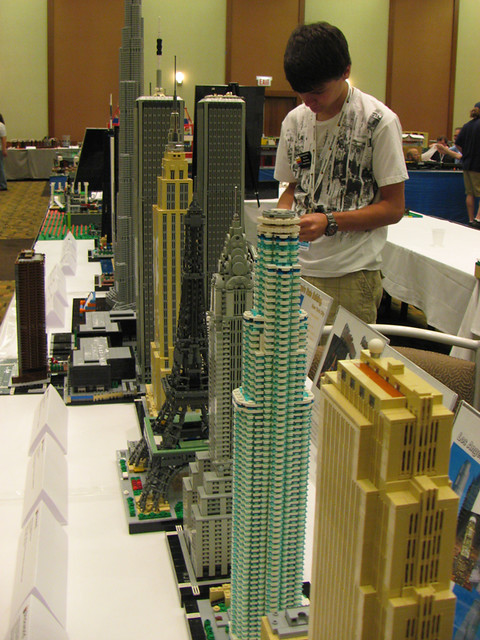 |
| LEGO World Financial Center (NYC) |
 |
| Rocco with his models at Brickworld, Chicago |
Only a few years older than myself, Rocco has undeniably mastered the craft of recreating architectural skyscrapers and landmarks using any and all of the LEGO elements that exist. He uses his bricks both wisely and creatively, and seems to produce a new Chicago skyscraper model every few months. Pictures of all of his LEGO creations can be found here. (I highly suggest taking a look: there are some really extraordinary techniques to appreciate in his builds).
By the way, I should note that all of his models are built on the same scale: 1:650
By the way, I should note that all of his models are built on the same scale: 1:650
 |
| Trump International Hotel & Tower next to the Wrigley Building |
RB: I am currently a second year architecture student at Illinois Institute of Technology in Chicago. Having grown up in Buffalo Grove, just northwest of the city, I have always loved the downtown area and all the excitement it has to offer. I started building LEGO sets at the age of six, and slowly worked my way beyond building just the sets. When I was fourteen, around the time I started to show an interest in architecture, I began building skyscrapers out of LEGO as a personal hobby.
MK: Why do you work with LEGO to recreate skyscrapers and landmarks? What are advantages, challenges, and benefits of working with LEGO as opposed to other mediums?
 |
| Chicago Board of Trade |
MK: What have you learned from LEGO? What can others learn from LEGO? Can you apply any of the knowledge you may have gained from working with LEGO to anything other than LEGO building?
Building things at such a small scale, for me, can teach many things that are applicable to a wide variety of activities or areas of study. For instance, figuring out how to make the interior of a model support the exterior finish is not unlike the way in which engineers discover new techniques and methods of construction.
 |
| Chase Tower (Chicago) |
MK: Your models are extremely technical, and I hear you are studying architecture at Illinois Institute of Technology. Has LEGO shaped who you are as a thinker and creator? If so, how? Did construction toys such as LEGO play a role in igniting your passion for architecture?
RB: LEGO has most definitely shaped the way I think. I would venture so far as to say that it's really similar to how it's easier to learn new languages when starting at a young age. I think starting out so early and keeping that going for the majority of my life has definitely made me think more technically and creatively.
MK: Do you consider yourself a part of a LEGO community? If so, how has being a part of that community helped you grow as a builder?
RB: I definitely consider myself as part of the LEGO community. I'm a member of the Kenosha LEGO Users Group (KLUG) and the Chicago Area LUG (ChiLUG), and I regularly attend Brickworld Chicago in June, not to mention I even worked at a LEGO Store for the holiday season a few years ago. Putting yourself out there with other people who build is really beneficial to you as a builder. Not only do you see other builders' techniques and building methods, but you're able to get feedback on your own methods as well.
 |
| (from left) One Prudential Plaza, Two Prudential Plaza, Aon Center, Aqua, and the Blue Cross Blue Shield tower |
No comments:
Post a Comment